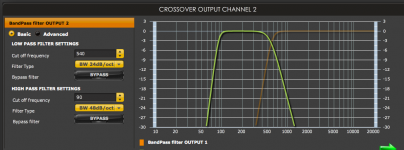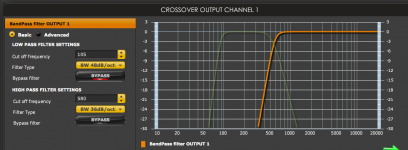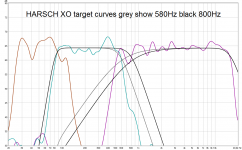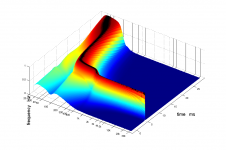That looks pretty good. The second and Third seems to be below -30db. No extra ordinary peaks except around 800hz and 2k for the second harmonics in red. (if used default REW colors) Third (orange) has a wide peak from 150 > 200. Do not know what causes this since the frequency seems to be 'flat' in comparison. Normally you would expect peaks in frequency also.
Maybe someone else with better understanding could enlighten me.
Maybe someone else with better understanding could enlighten me.
Great progress!Not sure if this is the right way to view it, but I just pulled this from that same overall measurement as the previous post
The level seems too low to say anything. The noise level when I'm measuring is usually around 30 dB.
At what distance is this?
Do a new measurement at 1 m and 90 dB.
/Anton
I will try to get some new measurements asap, but I gotta hop on a quick project this week for work. Might take me a few days to get to it.
Let me know if there is anything else I should look at! It sounds great but I am still down to test some different throats
Let me know if there is anything else I should look at! It sounds great but I am still down to test some different throats
I will try to get some new measurements asap, but I gotta hop on a quick project this week for work. Might take me a few days to get to it.
Let me know if there is anything else I should look at! It sounds great but I am still down to test some different throats
Did you purposely design the throat differently due to you using a different CD then Art? Nice that you seem to enjoy the sound from it:! I guess a pair would go well with the two keystones I've built🙂
Really nice response graphs.
Have you posted a raw un eq'd response? Just interested in the peaks in the distortion. If they are eq related or driver related, or enclosure design related?
It becomes a process of elimination when you have measurements.
You might try the insulation on the side walls with the paper towards the outside wall instead of the inside wall.
Usual installation method is to have the absorbing side on the interior of the cavity.
Have you posted a raw un eq'd response? Just interested in the peaks in the distortion. If they are eq related or driver related, or enclosure design related?
It becomes a process of elimination when you have measurements.
You might try the insulation on the side walls with the paper towards the outside wall instead of the inside wall.
Usual installation method is to have the absorbing side on the interior of the cavity.
Thought I saw in Art's directions to have the paper faced out, maybe I misinterpreted- that's what it sounds like. Also I was initially trying to build my throat adapter to the same spec as him- he used a 12mm thickness. I couldn't get much else information about it as far as measurements, so I went with what I had. I still don't understand how he was able to make it 1/2" thickness with the dimensions of the throat entry and not have a sudden expansion. But, that's fine, I'm just going to make mine 21mm which will give me enough room even for the corners to expand smoothly
I can say that you have a pretty nice looking response graph.
It should sound nice and clean.
Have you used a microphone that can be calibrated with the input settings of REW?
Because testing at 60 db is rather low.
It should sound nice and clean.
Have you used a microphone that can be calibrated with the input settings of REW?
Because testing at 60 db is rather low.
Dayton UMM-6 with calibration file. My thought process keeping it low volume was mainly not driving my roommates mad with all the sine sweeps 😉 Also I wanted to do measurements back at a more average listening position.. It was about 2-3m away and 1m off of the ground, inside a 5000sqft part of the warehouse with 16-20ft ceilings.. Luckily it was pretty quiet in the back section that day. Not exactly ideal conditions, but it made a very noticeable difference getting the crossovers set appropriately and doing some EQ adjustments using REW+miniDSP. I have limited outdoor places I can test it until I build the trailer it's going on, but I guess I could try taking it into the huge parking lot late at night!
I'll post a version with no EQ as well.
Do you think there would be any disadvantage to making the secondary expansion flush with the first? I am too in love with how awesome it looks to cover it with grill cloth! I could always add grill stuff later if it really needs it. I suppose I could always try it both ways to see how it does
I'll post a version with no EQ as well.
Do you think there would be any disadvantage to making the secondary expansion flush with the first? I am too in love with how awesome it looks to cover it with grill cloth! I could always add grill stuff later if it really needs it. I suppose I could always try it both ways to see how it does
Dayton UMM-6 with calibration file. My thought process keeping it low volume was mainly not driving my roommates mad with all the sine sweeps
Sure... Make sense!
You will find when measuring a horn like this that a farther away measurement will give you a more realistic representation of what it sounds like in actual use. Good you measured a few meters away.
Do you think there would be any disadvantage to making the secondary expansion flush with the first? I am too in love with how awesome it looks to cover it with grill cloth! I could always add grill stuff later if it really needs it. I suppose I could always try it both ways to see how it does
This question may not be for me, but I'll look first before I can comment.
OK I looked at your images of how the adapter lines up to the horn.
Without seeing un eq'd tweeter measurements and un eq'd Woofer measurements it is kind of hard to make any comments on the effects of the couplers termination.
And sadly even with the measurements it's basically a game of best guessing.
Some inferences can be made via overal dimensions and wavelength of sound.
Other inferences can be made from phase and impedance graphs.
Sometimes what can be most revealing is to place an object in front of the throat opening. Have a know set of dimensions and spacing from the throat and see what changes if any it makes.
This can be both enlightening and perplexing at the same time.
At times you really learn something about shapes and how they effect sound reproduction.
At other times you play with placing objects in front and perceive very little differences.
Without seeing un eq'd tweeter measurements and un eq'd Woofer measurements it is kind of hard to make any comments on the effects of the couplers termination.
And sadly even with the measurements it's basically a game of best guessing.
Some inferences can be made via overal dimensions and wavelength of sound.
Other inferences can be made from phase and impedance graphs.
Sometimes what can be most revealing is to place an object in front of the throat opening. Have a know set of dimensions and spacing from the throat and see what changes if any it makes.
This can be both enlightening and perplexing at the same time.
At times you really learn something about shapes and how they effect sound reproduction.
At other times you play with placing objects in front and perceive very little differences.
Jenny,Thought I saw in Art's directions to have the paper faced out, maybe I misinterpreted- that's what it sounds like. Also I was initially trying to build my throat adapter to the same spec as him- he used a 12mm thickness.
I never use paper backed fiberglass for cabinet damping, the paper can flap and make noise.
I use string and staples to hold fiberglass in place.
My SynTripP throat adapters are 1/2", not 12mm thick ;^).
Art
Jenny,Do you think there would be any disadvantage to making the secondary expansion flush with the first?
The grill cloth frame is half the transition angle from the initial to the secondary horn expansion. It improves the polar response when used without the secondary expansion, and smooths response when used with the secondary expansion.
Leaving the grill frame "naked" won't hurt the response, but eliminating the transition will.
Art
Hi Jenny,
Let the fun begin!!!
Constant directivity systems don't need to be voiced quite that flat up top, at high levels you can easily end up with ear fatigue. The hyper detailed quality is nice at low levels but unless you have loads of HF absorption in the venue your ears will thank you if you back off the top end a bit.
If you can take a few measurements of the mid and HF drivers without EQ (say 0°, 15°, 30°, 45° off axis to one side) using the same mic placement and drive voltage (say 2v @ 2-3m) either ground plane outdoors or sufficiently suspended mid air be useful (say 10') and post the raw REW files to your GD we can see if things can be improved upon with some passive components.
Let the fun begin!!!
An externally hosted image should be here but it was not working when we last tested it.
Constant directivity systems don't need to be voiced quite that flat up top, at high levels you can easily end up with ear fatigue. The hyper detailed quality is nice at low levels but unless you have loads of HF absorption in the venue your ears will thank you if you back off the top end a bit.
If you can take a few measurements of the mid and HF drivers without EQ (say 0°, 15°, 30°, 45° off axis to one side) using the same mic placement and drive voltage (say 2v @ 2-3m) either ground plane outdoors or sufficiently suspended mid air be useful (say 10') and post the raw REW files to your GD we can see if things can be improved upon with some passive components.
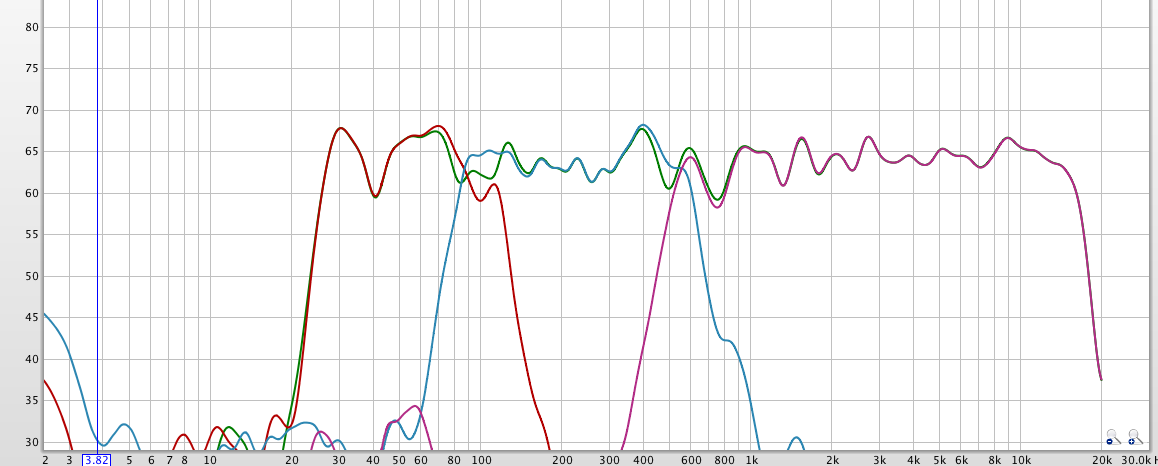
Nice work JG. That Faital Pro CD digs deep! You are almost in FAST territory so it's great for coherency.
Check to see if you can run the CD with a 2nd order high pass - the set delays to get a Harsch XO. If you do it right, the percussion will really snap. Subtle but unmistakable when done right.
http://www.diyaudio.com/forums/multi-way/277691-s-harsch-xo.html
Thanks for the details Art! I will rip the paper out and use string if it gets flakey.
I say 12mm as synonymous with 1/2" material (actual thickness 0.47"). I think we are on the same page. I know you don't like to do metric, that's okay! 🙂
Art, that sounds good with the grill frame transitioning to the secondary horn expansion. I think once again on the same page. The grill frame kind of blends between the primary and secondary horn flares... Makes a lot of sense!
Dan- I'm happy to do that! Just need to find some time. Right now I have to jam on a bit of dayjob stuff 😛
xrk- I am eager to understand the harsch XO and get things "slapping". Sounds like an effect that is worth the time invested. Right now I have the crossover between 10/CD as follows, with a 50 microsecond delay on the CD:
I say 12mm as synonymous with 1/2" material (actual thickness 0.47"). I think we are on the same page. I know you don't like to do metric, that's okay! 🙂
Art, that sounds good with the grill frame transitioning to the secondary horn expansion. I think once again on the same page. The grill frame kind of blends between the primary and secondary horn flares... Makes a lot of sense!
Dan- I'm happy to do that! Just need to find some time. Right now I have to jam on a bit of dayjob stuff 😛
xrk- I am eager to understand the harsch XO and get things "slapping". Sounds like an effect that is worth the time invested. Right now I have the crossover between 10/CD as follows, with a 50 microsecond delay on the CD:
Attachments
XRK,Check to see if you can run the CD with a 2nd order high pass - the set delays to get a Harsch XO. If you do it right, the percussion will really snap.
A second order HP on the compression driver is possible, but will increase it's distortion and reduce output level before the diaphragm hammers on the phase plug. The 10" drivers are better suited to cover the 900 Hz region.
A 24 dB crossover (at a higher frequency than what Jenny has run her low level tests at) is preferable, and when the phase is properly aligned will sound just as "snappy" as the Harsch alignment without requiring additional delay.
Art
Jenny,
The grill cloth frame is half the transition angle from the initial to the secondary horn expansion. It improves the polar response when used without the secondary expansion, and smooths response when used with the secondary expansion.
Leaving the grill frame "naked" won't hurt the response, but eliminating the transition will.
Art
I made the grill using a simple speaker cloth. (a cloth claiming to let all frequencies through evenly).
I also have made another frame with no cloth for when I want to use them without the cloth and with the secondary horn.
.....xrk- I am eager to understand the harsch XO and get things "slapping". Sounds like an effect that is worth the time invested. Right now I have the crossover between 10/CD as follows, with a 50 microsecond delay on the CD:
Don't know compression driver data and if it is capable but here overlay example with target slopes Bessel 2nd order at 580 or 800Hz. Surprised there is so many 8th order slopes the two below 100Hz ad quite some lag down there, wasn't weltersys running 4th order slopes.
Attachments
OK I looked at your images of how the adapter lines up to the horn.
Without seeing un eq'd tweeter measurements and un eq'd Woofer measurements it is kind of hard to make any comments on the effects of the couplers termination.
And sadly even with the measurements it's basically a game of best guessing.
Some inferences can be made via overal dimensions and wavelength of sound.
Other inferences can be made from phase and impedance graphs.
Sometimes what can be most revealing is to place an object in front of the throat opening. Have a know set of dimensions and spacing from the throat and see what changes if any it makes.
This can be both enlightening and perplexing at the same time.
At times you really learn something about shapes and how they effect sound reproduction.
At other times you play with placing objects in front and perceive very little differences.
I think I completely misunderstood what you were asking about Jenny.
Sorry.
I was referring to the junction between your printed throat adapter and the throat of the conical horn.
I should read a little more and type less sometimes.
Brytt,Don't know compression driver data and if it is capable but here overlay example with target slopes Bessel 2nd order at 580 or 800Hz. Surprised there is so many 8th order slopes the two below 100Hz ad quite some lag down there, wasn't weltersys running 4th order slopes.
Yes, the slopes used for the SynTripP are 4th order, described in post #9 and 13. I have since changed to a BSS Blu 100 crossover which allows for more filters, but the crossover parameters are still pretty close to the originals as described.
Art
- Home
- Loudspeakers
- Multi-Way
- SynTripP: 2-way 2-part Virtual Single Point Source Horn
